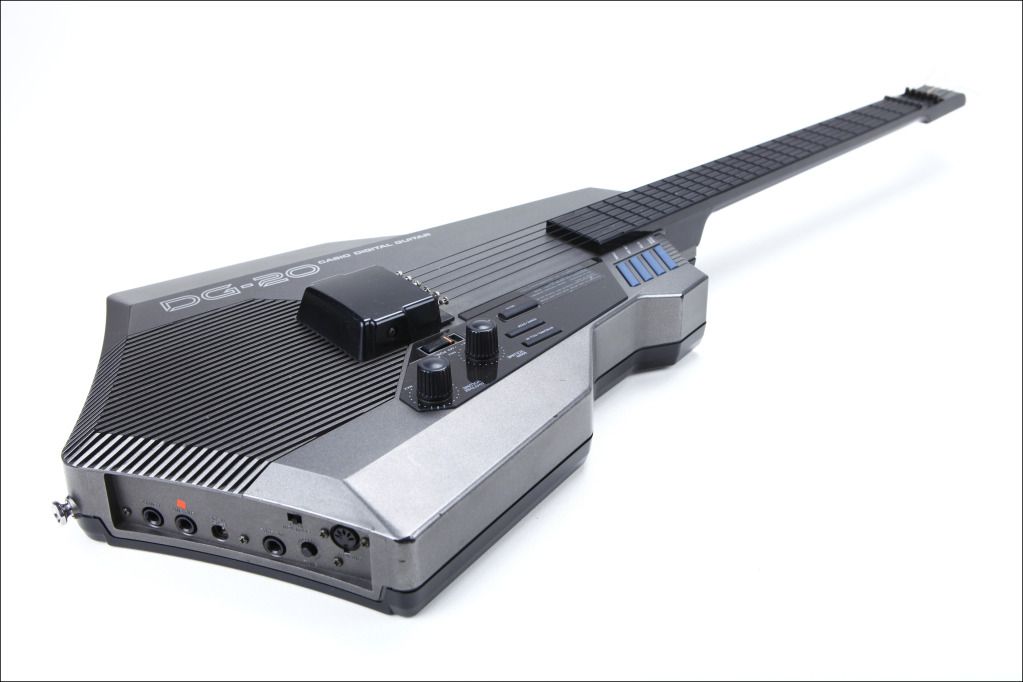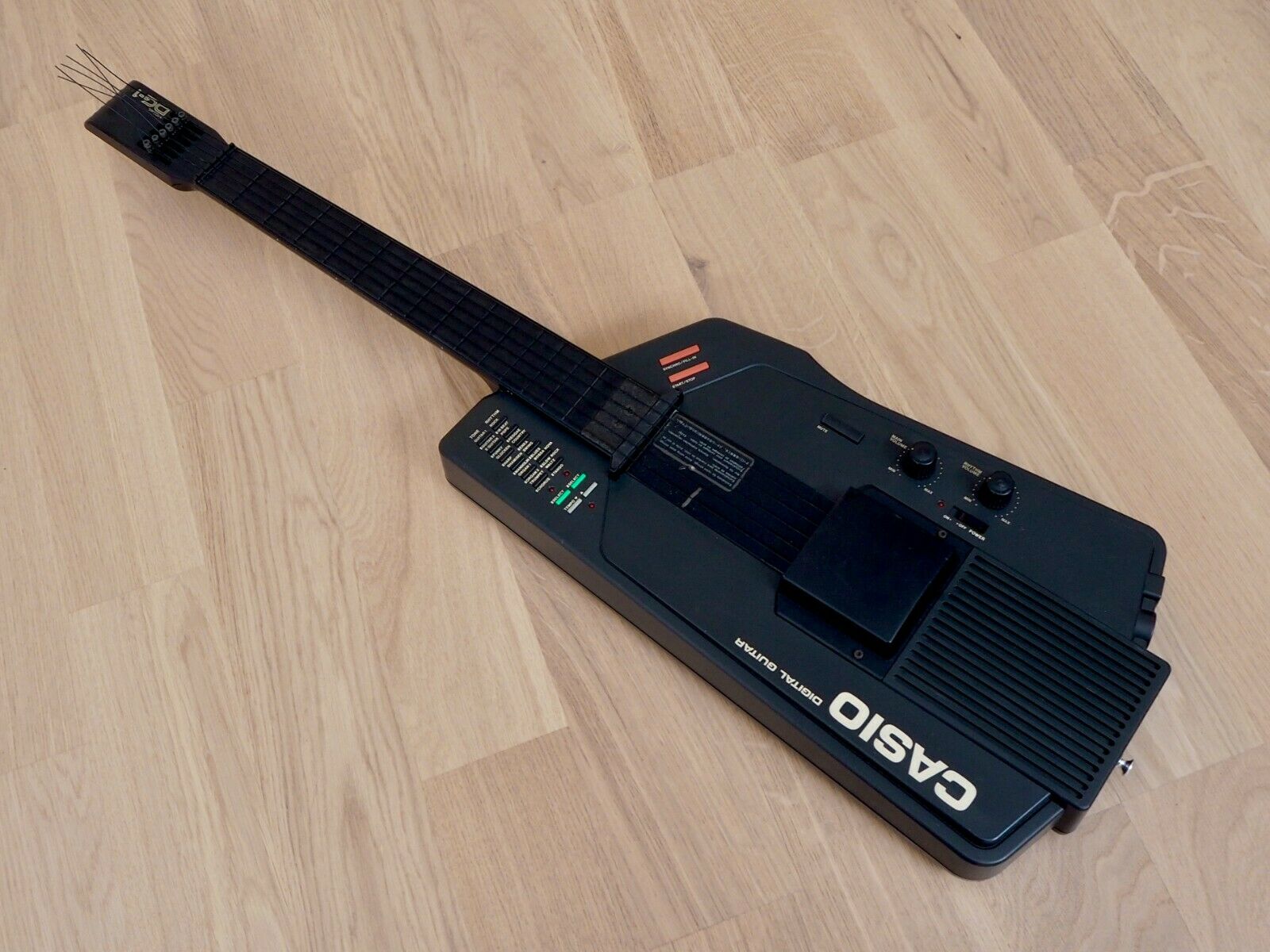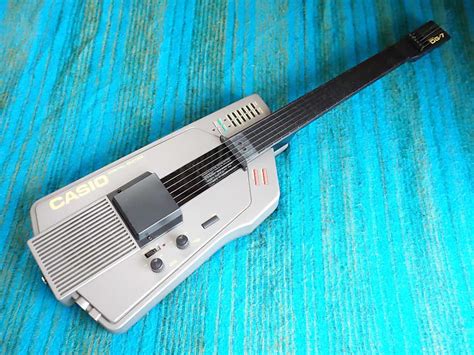

| CASIO DIGITAL GUITARSThe Casio DG-1, DG-10, and DG-20 |
||||||||||||||||||||||||||||||||||||||||||||||||||||||||||||||||||||||||||||||||||||||||||||||||||||||||||||||||||||||||||||||
 The Casio DG-series was a line of Digital Guitars released sometime around 1985 (though some sources say 1981). There were four models released: the DG-1, the DG-7, The DG-10, and the DG-20. The first one was the earlier release, the later one was released in 1987.
They were styled and built generally like kid's toys for the most part. No real serious players have played one except apparently one of the guys on "Flight of the Conchords" has a DG-10, and Joel Hodgeson played one in some skits on early Mystery Science Theater 3000 (DG-1). The DG-20 seems to be the most sought after because it has MIDI capabilities and drums pads on it, but it's really a minor step above the other two. The Casio DG-series was a line of Digital Guitars released sometime around 1985 (though some sources say 1981). There were four models released: the DG-1, the DG-7, The DG-10, and the DG-20. The first one was the earlier release, the later one was released in 1987.
They were styled and built generally like kid's toys for the most part. No real serious players have played one except apparently one of the guys on "Flight of the Conchords" has a DG-10, and Joel Hodgeson played one in some skits on early Mystery Science Theater 3000 (DG-1). The DG-20 seems to be the most sought after because it has MIDI capabilities and drums pads on it, but it's really a minor step above the other two.
How Does The Digital Guitar Work? For the layman, it's basically a Casio/Casiotone keyboard/table-hooter with a guitar-style interface. It sounds like a Casio keyboard, and the styling of these devices somewhat reflects that. The guitar features six 0.24 gauge nylon strings, tensioned by tensioners at the headstock. Unplugged, it makes no sound of it's own, and it just sounds like rustling plastic. Powered on, the six strings slap against a series of trigger pads located in the bridge to trigger (a) note(s). It determines the pitch of the note based on a series of membranes underneath the rubber fretboard. When the player presses down on the fretboard, it closes contacts that raises the pitch of the string the player is pressing down, so when it is played, it plays the proper pitch. These signals are then fed into a series of circuits that include a clipping circuit, a chorus circuit, a midi circuit, and a DAC (Digital to Analog Converter) circuit to create what you hear. Tuning is controlled by a inset pot (DG-1) or little trimpot knob (DG-10/20) on the back of the guitar and allows very limited variance. The DG-1  The Casio DG-1 has been said to be released as early as 1981, or as late as 1987. It features 12 instruments and 12 rhythms, with a drum machine, and can be tuned via a flat-head trimpot in the back.
The Casio DG-1 has been said to be released as early as 1981, or as late as 1987. It features 12 instruments and 12 rhythms, with a drum machine, and can be tuned via a flat-head trimpot in the back.
It seems the DG-1 was the one that sold the most as they are pretty easy to find and fairly decently priced if you look hard enough. Higher costs are around $390, while most seem to sell in the $100-200 range these days. I bought my own for $94 back in 2009. SPECIFICATIONS
VOICE LIST
The DG-7  The Casio DG-7 is basically a less common, and most likely Japanese exclusive variant of the DG-1. It comes in a lighter gray color but has the same body, same sounds, and same rhythms as a DG-1. It appears to be Japanese exclusive because I have not seen an example online that isn't in Japan, or has not been imported FROM Japan.
The Casio DG-7 is basically a less common, and most likely Japanese exclusive variant of the DG-1. It comes in a lighter gray color but has the same body, same sounds, and same rhythms as a DG-1. It appears to be Japanese exclusive because I have not seen an example online that isn't in Japan, or has not been imported FROM Japan.
The only real differences I can tell is that the body is a different color, and the model# changed to DG-7. Could it even just be a later release of the DG-1? SPECIFICATIONS
VOICE LIST
The DG-10 The DG-10 was introduced in 1987 along side the fancier model, the DG-20. The DG-10 SPECIFICATIONS
|